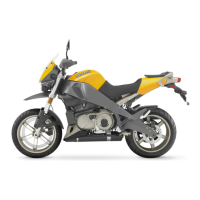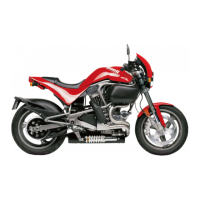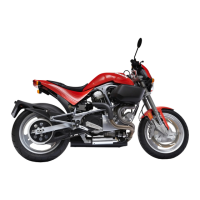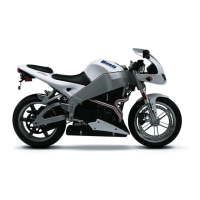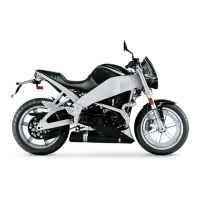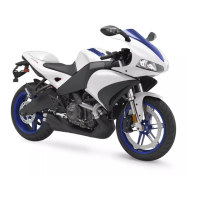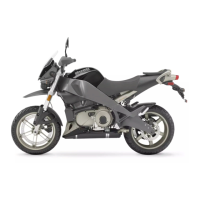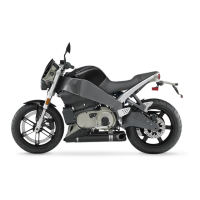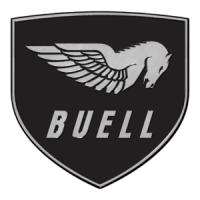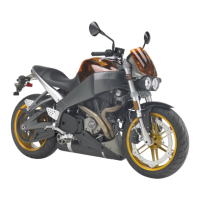1-2 2007 Buell Lightning: Maintenance
HOME
REPAIR AND REPLACEMENT
PROCEDURES
Hardware and Threaded Parts
Install helical thread inserts when inside threads in castings
are stripped, damaged or not capable of withstanding speci-
fied torque.
Replace bolts, nuts, studs, washers, spacers and small com-
mon hardware if missing or in any way damaged. Clean up or
repair minor thread damage with a suitable thread chaser.
Replace all damaged or missing lubrication fittings.
Use Teflon pipe sealant on pipe fitting threads.
Threadlocking Agents
Always follow specific service manual procedures when work-
ing with fasteners containing preapplied threadlocking agents
when fastener replacement is recommended.
When re-using fasteners containing threadlocking agents, be
sure to completely remove all existing threadlocking agent
from fastener threads with a wire brush or wire wheel. Also,
be sure to remove residual threadlocking agent from fastener
hole using an appropriate thread chasing device and com-
pressed air when using new or existing fasteners.
Always use the recommended threadlocking agent for your
specific procedure.
Wiring, Hoses and Lines
Replace hoses, clamps, electrical wiring, electrical switches
or fuel lines if they do not meet specifications.
Instruments and Gauges
Replace broken or defective instruments and gauges.
Bearings
Anti-friction bearings must be handled in a special way. To
keep out dirt and abrasives, cover the bearings as soon as
they are removed from the package.
Wash bearings in a non-flammable cleaning solution. Knock
out packed lubricant inside by tapping the bearing against a
wooden block. Wash bearings again. Cover bearings with
clean material after setting them down to dry. Never use com-
pressed air to dry bearings.
Coat bearings with clean oil. Wrap bearings in clean paper.
Be sure that the chamfered side of the bearing always faces
the shoulder (when bearings installed against shoulders).
Lubricate bearings and all metal contact surfaces before
pressing into place. Only apply pressure on the part of the
bearing that makes direct contact with the mating part. Install
bearings with numbered side facing out.
Always use the proper tools and fixtures for removing and
installing bearings.
Bearings do not usually need to be removed. Only remove
bearings if necessary.
Bushings
Do not remove a bushing unless damaged, excessively worn
or loose in its bore. Press out bushings that must be replaced.
When pressing or driving bushings, be sure to apply pressure
in line with the bushing bore. Use a bearing/bushing driver or
a bar with a smooth, flat end. Never use a hammer to drive
bushings.
Inspect the bushing and the mated part for oil holes. Be sure
all oil holes are properly aligned.
Gaskets
Always discard gaskets after removal. Replace with
new
gas-
kets. Never use the same gasket twice. Be sure that gasket
holes match up with holes in the mating part.
Lip Type Seals
Lip seals are used to seal oil or grease and are usually
installed with the sealing lip facing the contained lubricant.
Seal orientation, however, may vary under different applica-
tions.
Seals should not be removed unless necessary. Only remove
seals if required to gain access to other parts or if seal dam-
age or wear dictates replacement.
Leaking oil or grease usually means that a seal is damaged.
Replace leaking seals to prevent overheated bearings.
Always discard seals after removal. Do not use the same seal
twice.
O-Rings (Preformed Packings)
Always discard o-rings after removal. Replace with
new
o-
rings. To prevent leaks, lubricate the o-rings before installa-
tion. Apply the same type of lubricant as that being sealed.
Be sure that all gasket, o-ring and seal mating surfaces are
thoroughly clean before installation.
Gears
Always check gears for damaged or worn teeth.
Lubricate mating surfaces before pressing gears on shafts.
Shafts
If a shaft does not come out easily, check that all nuts, bolts
or retaining rings have been removed. Check to see if other
parts are in the way before using force.
Shafts fitted to tapered splines should be very tight. If shafts
are not tight, disassemble and inspect tapered splines. Dis-
card parts that are worn. Be sure tapered splines are clean,
dry and free of burrs before putting them in place. Press mat-
ing parts together tightly.
Clean all rust from the machined surfaces of new parts.
Part Replacement
Always replace worn or damaged parts with
new
parts.
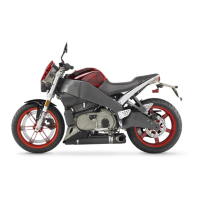
